The SOIL-CUBE METHOD is the ONLY method we recommend for germinating plant seeds.

The soil cube method uses an old-school farmer tool called a ‘soil-cuber’, or ‘soil-block’ that can be used for nearly any type of plant seed.. It is a contraption made of steel and has a spring-loaded handle with 4 to 10 ‘blocks’ of various sizes (depending on which model you get) that you pack soil into and then with the squeeze of a handle the soil-cuber drops/unloads the compacted soil blocks into their positions.
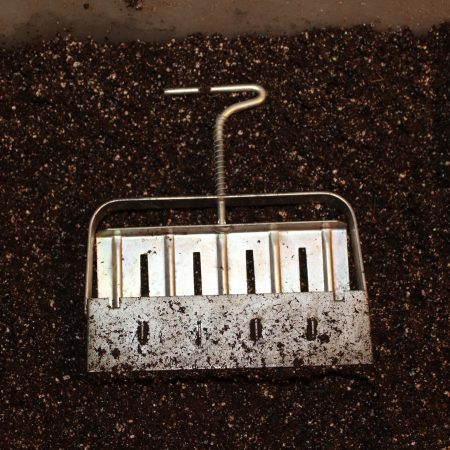
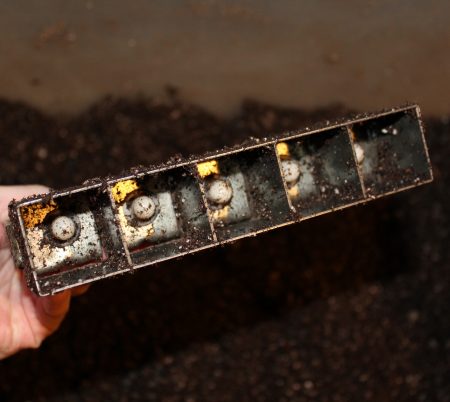
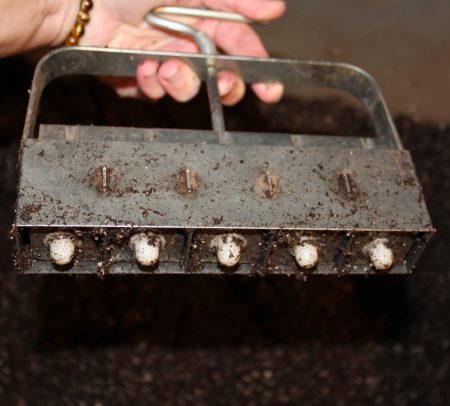
We like to put our soil-blocks in standard-sized black nursery trays with a propagation dome over the top. We usually do 8 rows with 4 soil-blocks in each one, totaling 32 soil cubes per tray. However, 40+ cubes per tray is possible.
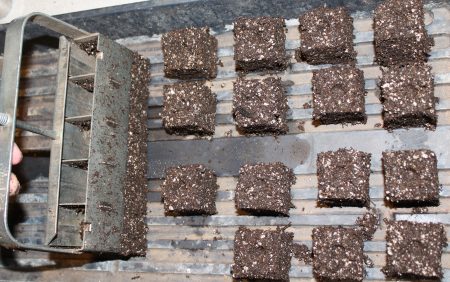
Before you start, it is important to make sure the soil is more wet than dry or it will not be the right consistency to clump (or stay clumped) together. This will take a bit of experimenting when you’re first getting started. We then write labels for each row, or sometimes even each soil cube with the proper plant identification. We then place seed(s) in or on each soil cube, and then with our hands we cover the seeds by rounding off the soil cube and compacting it once more. We then carefully place the label in or next to the appropriate soil-cube. The last step is to add a bit more water to the bottom of the tray, so the soil cubes are evenly soaked (but not overly so). Then put the propagation dome on top and set on top of a heating pad, or another means of adding a little extra heat underneath the tray.
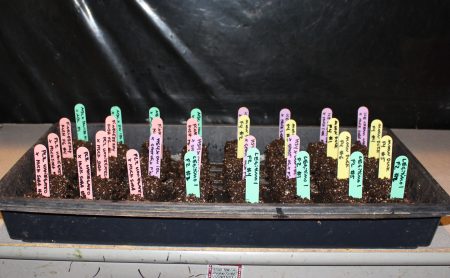

Once the seedlings reach a couple inches tall and/or the roots are growing out of the sides or the bottom of the soil-cubes then they can be carefully picked up (without disturbing the roots whatsoever- isn’t that nice?) and transplanted into a larger growing container, undisturbed and ready to take off.
The soil-cube method is so successful because it’s as simple as it gets and really just lets nature take its course. After all, plants grow in soil, don’t they?
We have tried the ‘drop in water’ method or ‘paper towel’ method and while those work fairly well, the problem typically arises only after the seeds have tailed because all too often once the tailed-seed is transplanted into soil or rock-wool (please don’t) and they fail to pop up out of the soils surface. Why? A few reasons… most of which can be avoided by simply planting the seeds in soil to start!
When using viable seeds many times they pop out of soil within 48 hours, which in some cases saves a couple days germinating seedlings.
One of the key factors that contributes to the success of this method is that it allows the free exchange of air, as the soil cubes are exposed on all four sides and on top too. This is beneficial because once the seeds sprout the roots will require as much air as they do water… and they will be searching for both. With the vented propagation dome over head one can adjust the amount of air exchange to maintain the proper humidity levels. One might even be inclined to drill a few extra holes in top of the propagation dome just to allow more air flow.
The days following germination are the days when seedlings are the most vulnerable and can succumb to root rot or damping off, and it happens often, so once the majority of the seeds in the tray have germinated, remove the propagation dome or leave it ajar/skewed on the nursery tray until it can be removed entirely.
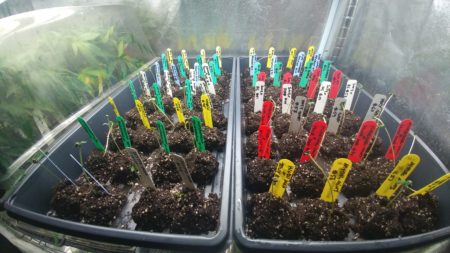
When it comes to watering brand new seedlings, less is more. Don’t give them any if they don’t need it in that moment.
If your current germination method is broken, could use improvement, or you just want to try something new, the Soil-cube method is simple, efficient, natural, and effective. It’s the method we recommend to folks every single time, hence us writing this article!
Assuming healthy, viable seeds, one can expect 95%-100% success rates.
